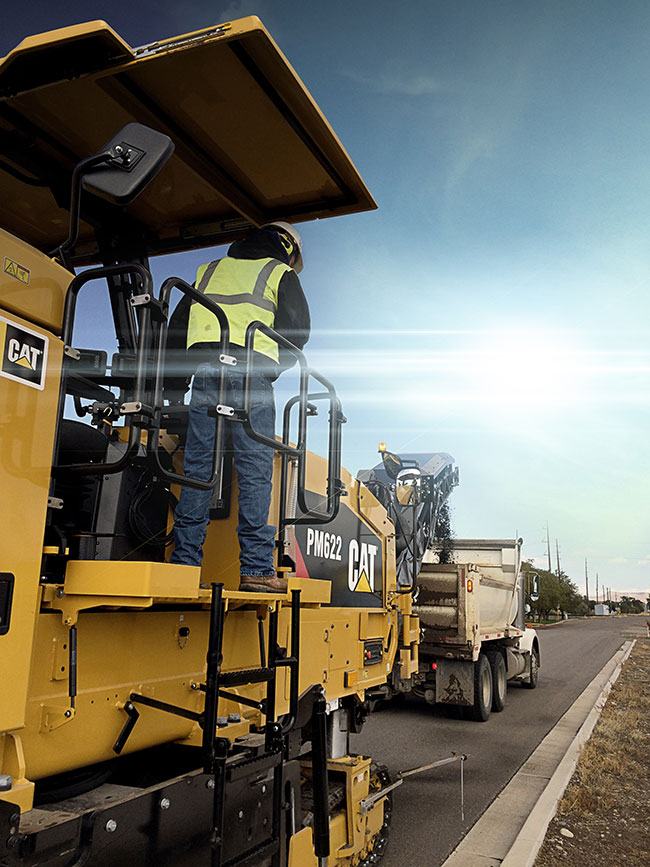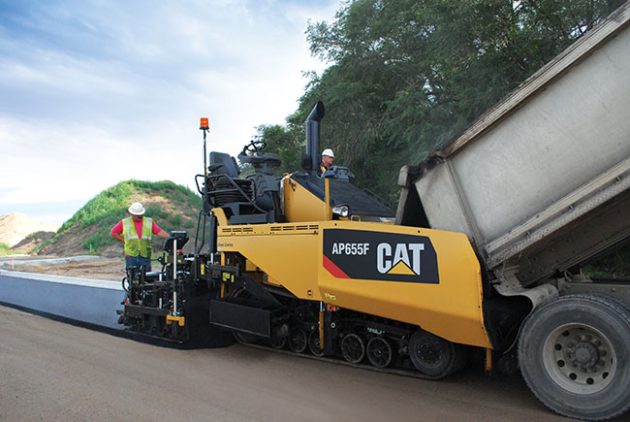
Features
Roads & Paving
Technology
Driving paving forward with technology
How innovation is changing the industry and promoting competition
November 16, 2021 By Sheldon Allan

Keeping infrastructure paving projects running smoothly involves a considerable amount of planning due to the complex logistics involved – working with an extremely temperature-sensitive material and getting everything just right the first time, despite environmental conditions, transportation considerations and the precision of the work involved.
Which means contractors not only need to know how to operate incredibly specialized equipment, they also need the skills to deliver accurate and precise work under extreme time pressures, tight budgets and an ever-stricter regulatory environment.
Technologies like equipment telematics, thermal mapping and process monitoring solutions are starting to shape the paving industry. This is helping improve the speed, accuracy, productivity and the quality of work, having a real-time effect on the entire paving process.
Telematics is driving change
Telematics is re-shaping every aspect of paving operations. It is key to remote equipment utilization and health and is working to automate processes that were previously done manually. From back-office accounting to jobsite execution, data from telematics can be tracked in real-time, providing information to help optimize fleet performance and reduce costs.
With paving equipment constantly moving from site to site, clear communication between trucks transporting material, equipment operators and the back office can be a challenge. Knowing where your equipment is makes it possible to dispatch the next machine at the right time, move equipment around between sites based on unpredictable variables such as weather and traffic and be more flexible in terms of operational needs.
This can minimize delays, speed up paving production, and helps avoid the steep cost of downtime. Telematics can also help you access data on machine hours and location, plan for equipment repairs and scheduled maintenance, and order parts for just-in-time delivery. It can also be linked with apps and software programs and updates can be done remotely to ensure you always have access to the latest software.
The future of telematics holds even deeper insights on real-time machine health, productivity, and remote troubleshooting. Along with remote services, you can optimize performance and productivity of your fleet with the latest software updates.
Measurement technology is creating greater efficiencies
The right compaction is essential to the durability of a road surface and is a critical component in quality and uniformity of pavement layers. By controlling consistency and process improvements you gain greater accuracy.
Compaction measurement technology for asphalt is accelerometer-based, which means it can measure the stiffness of the different layers (wear/intermediate/binder) and a portion of the material in the base depending on the paving stage and thickness being compacted. It measures up to two-feet deep on all layers, gauging the overall stiffness of the surface and allows you to see data in real-time to make adjustments as needed, which means guesswork is eliminated and operators can ensure complete coverage and uniform layers, gaining up to 30-per-cent greater efficiency.
Temperature is also key to successful compaction. When it comes to the rolling process, there are three different temperature zones, and each compactor must stay within a certain temperature range. In the past, operators relied on handheld infrared thermometer guns to test the temperature of the mat manually.
With temperature indication technology, the surface temperature is displayed on board in real time using infrared (IR) sensors mounted on the front and rear of the machine. This allows roller operators to have an accurate indication of temperature and make rolling pattern corrections when required to ensure optimal compaction in the correct temperature range, achieving up to 15-per-cent higher performance with less chance of re-work.
Thermal regulation technology helps to build more durable surfaces
Compacting thermally segregated asphalt creates different densities across the surface of the road impacting safety and surface durability. With thermal regulation technology we are seeing more durable, longer lasting surfaces that can handle greater loads and high traffic volumes.
One of the biggest challenges is understanding the temperature variations and specifications for smoothness. Thermal mapping monitors the surface temperature of the asphalt mat behind the paver using an infrared sensor and/or camera along with a global navigation satellite system mounted on the back of the paver to look for and map thermal variations. The cameras are within a couple of degrees of the actual surface temperature and, being so accurate, they can provide early detection of thermal variation.
By viewing temperatures in real-time, contractors can identify any variations, taking action immediately to fine-tune the work as they go, resulting in up to 15-per-cent better consistency and more uniform lay-down temperatures.

Technologies like equipment telematics, thermal mapping and process monitoring solutions are starting to shape the paving industry.
Photo: Caterpillar
3D machine control technology is increasing accuracy
With advancements in machine control technology, the days of manually assessing a job and hoping it’s “good enough” are gone. This technology allows paving and milling teams to improve productivity, control materials and increase the smoothness of the surface.
Most contractors are accustomed to using 2D technology when paving or milling a road surface. It works by using an external reference such as the existing road or curb and gutter. If the previous job was done correctly and the road has not deteriorated, 2D can provide the desired results.
With 3D technology, you now have the ability to scan the road surface, map out its defects and create a digital design file to determine how far down asphalt needs to be removed and the exact amount of material required for the job. This information is then uploaded directly to the machine.
This means not only greater accuracy but the flexibility to identify which sections are uneven and adjust accordingly to give you up to a 25-per-cent smoother surface and greater accuracy on the finished product. Using the digital design files, contractors can identify problem areas up front before the milling process even starts, providing huge cost savings, productivity gains and reduction in material wastage.
With the speed of advancements in technology, there is also a high likelihood that technologies like 3D machine control could become a requirement for large infrastructure tenders in the near future.
Process monitoring solutions helps production flow
Managing material transport from the plant to the jobsite is a constant challenge. Coordinating the movement of trucks due to traffic or delays at the plant can cause major issues that can impact the success of the job. Previous tracking involved using a manual ticket system with little communication between crews and drivers. Making vehicle location and estimated delivery time a guessing game.
Process monitoring solutions allow paving operators to deliver material exactly when and where it is needed by tracking deliveries from the plant to the paver in real-time. Site managers can see each cycle time of the truck, from wait time, to route travelled, and identify if any delays are expected so they can make adjustments as needed, boosting productivity by up to 15 per cent.
The future of paving
Technology will continue to create greater efficiencies in paving, streamlining operations and creating an indispensable advantage. While other industries are seeing a faster uptake in technology use, the paving industry has remained more traditional in its methods, preferring to execute tasks manually — but that is changing.
The industry is starting to see a greater demand for technology and the government could soon start to require it as a standard for public tenders. Early adopters of paving technology are reaping the benefits by setting themselves apart from the competition, winning more bids, getting jobs done faster with more accuracy, and seeing a positive impact on the bottom line.
Sheldon Allan is a paving and compaction product manager for Finning.
This article appears in Rock to Road‘s 2021 Buyers’ Guide.
Print this page